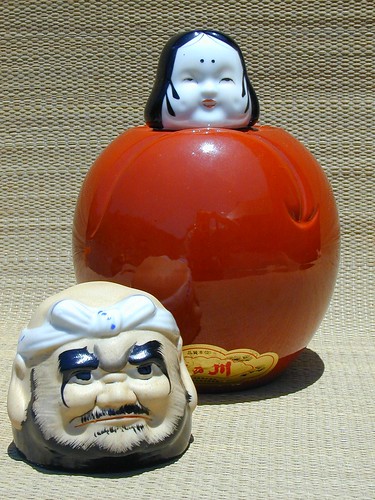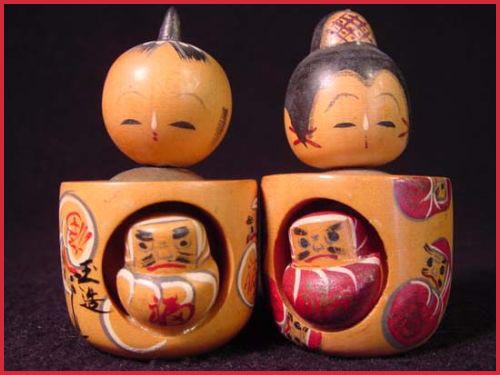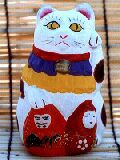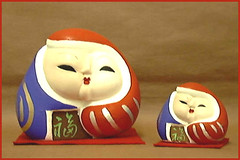:::::::::::::::::::::::::::::::::::::::::::::::::::::::::::::::::::::::::::::::::::::::::::::::::::::
Meoto Daruma and Takasago - 高砂
Daruma and a Happy Couple
fuufu Daruma 夫婦だるま
The Takasago Legend 高砂伝説
This legend is one of the oldest in Japanese mythology. An old couple - his name is Joo (尉) and hers is Uba (媼) known together as Jotomba - are said to appear from the mist at Lake Takasago. The old man and his wife are usually portrayed talking happily together with a pine tree in the background. Signifying, as they do, a couple living in perfect harmony until they grow old together, they have long been a symbol of the happiness of family life. The story is portrayed in a famous Noo play "Takasago no Uta":
 At Takasago Shrine there is a very old pine tree, the trunk of which is bifurcated (相生の松); in it dwells the spirit of the Maiden of Takasago who was seen once by the son of Izanagi who fell in love and wedded her. Both lived to a very great age, dying at the same hour on the same day, and since then their spirits abide in the tree, but on moonlight nights they return to human shape to revisit the scene of their earthly felicity and pursue their work of gathering pine needles.
At Takasago Shrine there is a very old pine tree, the trunk of which is bifurcated (相生の松); in it dwells the spirit of the Maiden of Takasago who was seen once by the son of Izanagi who fell in love and wedded her. Both lived to a very great age, dying at the same hour on the same day, and since then their spirits abide in the tree, but on moonlight nights they return to human shape to revisit the scene of their earthly felicity and pursue their work of gathering pine needles.His pine tree is also called "The Pine of Sumi-no-e" (住吉の松) and hers is the Takasago pine (高砂の松). The old woman is using a broom to sweep away trouble and he carries a rake to rake in good fortune. In Japanese this is also a play of words with "One Hundred Years" (haku > sweeping the floor) and "until 99 years" (kujuku made > kumade, meaning a rake).
In Japan, at wedding ceremonies, the Takasago song is recited and Takasago figures are put on a special "Island Shelf" called called Shimadai (島台) together with auspicious Pine-Bamboo-Plum and Crane with Turtle decorations placed in the wedding room and presented to the bridal couple. Depictions of the Takasago figures can be made from lacquer, ceramics, wood carvings and textiles and are to invoke a long and fruitful married life for the newlyweds. These figurines are also given as presents for a wedding aniversary of 25 or 50 or more years. For the diamond wedding aniversary of 60 years, some communities also give Takasago Dolls to the happy couple.
Takasago city is located in Hyogo prefecture in Western Japan. It is situated on the Seto Inland Sea approximately 40 kilometers west of Kobe. The settlement that became Takasago city was established on the delta at the mouth of the Kako River. This river formation gave rise to the name of "taka" "sago" which literally means "high" "sand", a reference to the vast amounts of sand deposited at the mouth of the Kako River.
Takasago is well known as the birthplace of classical song "Yookyoku Takasago", which is a famous wedding song throughout Japan, and thus the town was declared as "The Bridal City Takasago" in 1988.
Takasago Shrine 高砂神社
. . . CLICK here for Photos !
According to the shrine's legend, when the Empress Jinguu returned in triumph from Korea, her ship stopped at Takasago port. She built a large shrine to maintain control of the country. Keep reading more about this old legend on the following HP.
神功皇后が韓国から戻ったとき、船が高砂に着いたといわれています。
. Jingu Kogo 神功皇后 and Japanese Dolls .
.................................................................................
Text of the famous Wedding Song Takasago 高砂や
高砂や、この浦舟に帆をあげて、この浦舟に帆をあげて、月もろともに出で潮の、波の淡路の島影や、遠く鳴尾の沖過ぎて、
はや住の江に着きにけり、
はや住の江に着きにけり。
Takasago Bay!
Raising the sail on this cable,
together with the moonrise, the rising tide.
See, the reflection of Awaji Island
bove the waves far past the offing at Naruo.
We have reached Sumi-no-e, already.
We have reached Sumi-no-e, already!
The Noo Play of Takasago 能の高砂
. . . CLICK here for Photos !
You find a full translation of the Noo Play (Noh Play) "Takasago" on the following HP.
http://etext.lib.virginia.edu/japanese/noh/TylTaka.html
:::::::::::::::::::::::::::::::::::::::::::::::::::::::::::::::::::::::::::::::::::::::::::::::::::::::

Collection Gabi Greve
Takasago Dolls -
as children, with masks of the old couple
:::::::::::::::::::::::::::::::::::::::::::::::::::::::::::::::::::::::::::::::::::::::::::::::::::::::
誰をかも知る人にせむ高砂の
松もむかしの友ならなくに
Tare o ka mo Shiru hito ni sen Takasago no
Matsu mo mukashi no Tomo nara naku ni
Who is still alive
When I have grown so old
That I can call my friends?
Even Takasago's pines
No longer offer comfort.
34 - Fujiwara no Okikaze 藤原興風
. Ogura Hyakunin Isshu Poems 小倉百人一首 .
:::::::::::::::::::::::::::::::::::::::::::::::::::::::::::::::::::::::::::::::::::::::::::::::::::::
Takasago Dolls 高砂人形 Takasago Ningyoo
 These figurines are usually a present for a wedding or wedding anniversary, as we have stated above. They are very carefully made and quite expensive, as suits the occasion. Usually the old man is placed on the left and the old lady on the right, as you face them. This is the traditional position for a pair at a wedding of the nobility. But lately at weddings the bride stands on the right side. Maybe this is a copy of the position of the Royal English Couple? Since olden times, the seat on the right has been the "Elevated Seat" (kamiza 上座) for the most noble person in the room. So maybe the position of the bride has changed in this way? We may only wonder who is the most important person at a wedding.
These figurines are usually a present for a wedding or wedding anniversary, as we have stated above. They are very carefully made and quite expensive, as suits the occasion. Usually the old man is placed on the left and the old lady on the right, as you face them. This is the traditional position for a pair at a wedding of the nobility. But lately at weddings the bride stands on the right side. Maybe this is a copy of the position of the Royal English Couple? Since olden times, the seat on the right has been the "Elevated Seat" (kamiza 上座) for the most noble person in the room. So maybe the position of the bride has changed in this way? We may only wonder who is the most important person at a wedding.The groom says: "You will live until one hundred (haku made>using the broom), I will live until ninety nine (kujuku made>kumade>using the rake), together we will live happily until our hair turns white!"
.................................................................................
Takasago Dolls belong to the group of "Storytelling Dolls", depicting scenes of famous stories, actors, dancers or "tableaux" from familiar tales, often Noo plays.
Takasago Dolls of the Nara type -
Nara Ningyoo 奈良人形
 Nara Dolls typically represent Noo actors. Small wooden Noo figures painted in vivid colours were first used to decorate the hats of priests and musicians at the Kasuga Shrine festival in Nara. Other well known subjects are represented by Nara dolls, such as Jo and Uba, the happy old couple of Takasago.
Nara Dolls typically represent Noo actors. Small wooden Noo figures painted in vivid colours were first used to decorate the hats of priests and musicians at the Kasuga Shrine festival in Nara. Other well known subjects are represented by Nara dolls, such as Jo and Uba, the happy old couple of Takasago.Trees growing close together or two stems from one trunk are also called "meoto".
Meoto sugi 夫婦杉 pines growing like a couple
. . . CLICK here for Photos !
:::::::::::::::::::::::::::::::::::::::::::::::::::::::::::::::::::::::::::::::::::::::::::::::::::::
By chance I found a surprising Daruma item related to Takasago while writing this story.

Click on the photo to see the single figure.
At first it looks like some standing decoration figure, but as you might remember from the story about Sake pourers (Tokkuri) that the head comes off to become a little sake cup. This one is more wonderous. The head with the headband comes off and woo, there is a ladie's head beneath it. That one comes off too to bring you two cups for a happy couple.
Inside the head of Mr. Daruma we read:
"I will live until ninety-nine!" and
inside the head of Mrs. Daruma we read:
"I will live until one hundred!",
reminding us of the Takasago story and the hope that the wife will live just one year longer than her husband. The little tokkuri is just 11 cm high and nicely rounded to fit in a small hand.
:::::::::::::::::::::::::::::::::::::::::::::::::::::::::::::::::::::::::::::::::::::::::::::::::::::

source : kyoudogangu.xii.jp
Monkeys as the Takasago couple 高砂(申)
clay dolls from Nagoya
. Regional Folk Toys from Japan .
:::::::::::::::::::::::::::::::::::::::::::::::::::::::::::::::::::::::::::::::::::::::::::::::::::::
Meoto Daruma 夫婦だるま Mr. And Mrs. Daruma

MEOTO can also be read FUUFU and a memorial day for happy couples is the second day of the second month, 2月2日、since FU means TWO. Some hotels and restaurants also give special reductions for couples on the 22 of any month.
And if you blow on a hot soup in Japanese, your sound is: Fuu Fuu.

You buy them as a pair and keep them to remind you of the endurance and perseverance it takes to make a marriage sucessfull. They are sold at special temples and shrines dedicated to finding and keeping a partner for life. In some areas, dolls of the Daruma Couple are burned on the last day of the New Years festiviteis. Look at more pictures of this festival on January 14th.

I already introduced a nice couple in the story of Wakasa Laquer.
Wakasa Daruma ― 若狭 だるま Laquer and achate stone
A Daruma Couple is from the Great Shrine at Miwa.
 In the large compounds of this shrine there is a sacred stone formation like a loving couple (meoto-iwa 夫婦岩)、and the gate leading to this stones is called "Gate of bringing together a loving couple" (enmusubi no torii 縁結びの鳥居). Our Daruma seems to be growing a beard, since his chin is colored in light gray. They are both made of papermachee, about 4 cm high and come in a little box.
In the large compounds of this shrine there is a sacred stone formation like a loving couple (meoto-iwa 夫婦岩)、and the gate leading to this stones is called "Gate of bringing together a loving couple" (enmusubi no torii 縁結びの鳥居). Our Daruma seems to be growing a beard, since his chin is colored in light gray. They are both made of papermachee, about 4 cm high and come in a little box.You can learn more about this wonderful shrine and the legends of this old site on the following HP.
http://www.oomiwa.or.jp/eng.html
.................................................................................
A couple within a couple of kokeshi dolls

and some manekineko cat with a Daruma couple

.................................................................................
Next we have a couple from Arima Hot Spring near Kobe City.
Legend has it that the Arima Hot Spring was discovered by the ancient gods and that it was inherited from an era of myths and legends. The Arima Hot Spring is the oldest hot spring in Japan and the name of the Hot Spring itself dates back to at least the Man-yoohshuu, the oldest anthology of Japanese poetry.
The Daruma couple is made of wood and they are standing in front of a folding screen like at a wedding reception. They are about 2 cm high, the screen is 5 cm. Mr. Daruma's belly is painted in white lines, hers in red.
http://www.arima-onsen.com/
http://www.kinzan.co.jp/
:::::::::::::::::::::::::::::::::::::::::::::::::::::::::::::::::::::::::::::::::::::::::::::::::::::

Once a merchant had hung up the Takasago figures at the top of his entrance. It was a prosperous sweet shop.
Then the house and shop moved, but the Takasago figures did not like it at all, so they had to be left at the entrance.
In Aomori a girl left her family home to become a bride and live with her husband and an old couple who looked just like the Takasago elders. When the bull turned back, after the girl had descended to go inside, in his footsteps delicious Sake begun to sprinkle over the road. The girl has first thought to open a Sake making shop but now she turned it into a Sake drinking pub.
The husband eventually divorced his wife, but the shop came into decline soon after that.
- source : nichibun yokai database -
:::::::::::::::::::::::::::::::::::::::::::::::::::::::::::::::::::::::::::::::::::::::::::::::::::::
Enmusubi and more Happy Couples
縁結びだるま
If you are still looking for a good spouse, then you must pray to find a partner for life (enmusubi 縁結び). There are many shrines and temples in Japan specializing in this field of human activities and our Daruma sometimes comes as a go-between.

koimusubi 恋むすび binding together in love
with a little fragrance bag (nioibukuro) to go!
There are lot of amulets and talismans for all kinds of problems in life. One of them is the "Enmusubi Daruma", which often comes as two little plastic Darumas with a little bell each. This one was purchased at Tsuruga Castle in Aizu Wakamatsu.
. . . CLICK here for Photos !
There are some shrines in Japan, dedicated to happy couples.
Here are just a few samples.

from . Shrine Akama Jingu 赤間神宮 .
fuufu wago 夫婦和合 for a harmonious couple
fuufu omamori 夫婦守り happy couple amulet
ryooen jooju 良縁成就 to keep a good match
The Waka Poet
. Kakinomoto Hitomaro 柿本人麻呂 Hitomaru 人丸 / 人麿 .
is venerated as a Deity for Good Couples at
Hitomaru Jinja 人丸神社
in the compound of Ikuta Shrine 生田神社 .
兵庫県神戸市中央区下山手通1-2-1 Kobe

. wagoojin 和合神 Wago-Jin - Deity of conjugal harmony .
葛飾北斎 Hokusai - 萬福和合神 Manpuku Wago-Jin
.......................................................................
Shinzan Jinja 新山神社(夫婦神社)
夫婦松 Pine for a couple
. . . CLICK here for Photos !
Saifuku Meoto Jinja 齎福夫婦神社
Meoto Jinja in Osaka 大阪の夫婦神社
Meoto-Matsu at Akiba Jinja
Kasukabe no meoto matsu 春日部の夫婦松
Meoto-matsu, the married pine tree, is truly a natural wonder. A pine tree and maidenhair tree grow from a single trunk, branching out separately about a meter above ground. Meoto-Matsu was the sacred tree of Akiba-jinja Shrine.
. Izumo Taisha 出雲大社 Izumo Grand Shrine .
and the powerful enmusubi amulet
. Fushimi Inari Fox Shrine 伏見稲荷大社 .
Kyoto
. Hikawa Jinja 氷川神社 Saitama .
. Kifune Shrine 貴船神社 Kibune in Kurama .
Kyoto
むすび守袋型 Musubi bag form
むすび守文型 Musubi letter form
. . . . . and
. enkiri 縁切り to cut the bonds with someone .

akuen kiri omamori 悪縁切御守 to cut bad partnership
. Wara ningyoo 藁人形 straw dolls for curses .
:::::::::::::::::::::::::::::::::::::::::::::::::::::::::::::::::::::::::::::::::::::::::::::::::::::::

八百万の縁結び
六所神社 Rokusho Jinja - Tottori
:::::::::::::::::::::::::::::::::::::::::::::::::::::::::::::::::::::::::::::::::::::::::::::::::::::::

CLICK for more photos !
縁結び不動明王 Enmusubi Fudo Myo-O
near Joojuu-in 成就院 Joju-In, Jojuin Kamakura
- reference -
. Fudō Myō-ō, Fudoo Myoo-Oo 不動明王 Fudo Myo-O
Acala Vidyârâja - Vidyaraja - Fudo Myoo .
:::::::::::::::::::::::::::::::::::::::::::::::::::::::::::::::::::::::::::::::::::::::::::::::::::::::
Doll for a Lucky Couple Fukumusubi no Ningyoo
福結びの人形
In the collection of old Japanese legends, Koojiki, we read the story of Emperor Nintoku who fell in love with a fair princess of the Kibi area (present day Okayama prefecture) and came all the way by ship from Kyoto to meet her. Remembering this sweet love we have a papermachee doll of one body with two faces.
You can buy one at Okayama station or other famous tourist places in the prefecture. If you get one you have to write your own name and the name of your beloved on two slips of paper, make a longlasting knot of the slips and hide them inside the doll while wishing for a happy future for the both of you. That should do the trick!

Here is one more special pair designed as ONE Daruma Doll with two faces. The producer, Mr. Nisaburo Yamashita had so many customers who wanted a male and female Daruma、 he decided to make it easier for them to buy just ONE doll.
両面だるま 山下仁三郎作
男達磨と女達磨
. Folk Toys from Okayama .
.................................................................................
Some Daruma Families だるま家族
Let us look at some happy Daruma families too, while we are at this subject.

Here is a group of Father, Mother and Child from Kibitsu Shrine, in the same area of Okayama prefecture as we have talked about above. They are made of clay (tsuchiningyoo 土人形) and are about 3 cm high. Father Daruma has a round face with only a round spot in the middle. Baby Daruma has a white bottom and both mother and child have very simple facial features. All three of them have a very heavy and broad bottom part. They are sold as a talisman for finding a partner, keeping one and having children with him. This talisman had been out of making for a while, but now you can get the funny family again.
. Shrine Kibitsu Jinja 吉備津神社 .
. Mingei Kukkii みんげいクッキー Mingei Folk Art Cookies .
Kibitsu Jinja Daruma 吉備津神社 だるま
. Folk Toys from Okayama .
:::::::::::::::::::::::::::::::::::::::::::::::::::::::::::::::::::::::::::::::::::::::::::::::::::

Kiyomizuyaki pottery from Kyoto
. WASHOKU - Meoto Tablewear for a happy couple
. Hashi 福だるま夫婦箸 Chopsticks for a happy couple !
. WASHOKU
enmusubi manjuu 縁結び饅頭 rice cakes
from Izumo Shrine, Shimane
Couple’s Day (fuufu no hi, Japan) February 2
a KIGO
Daruma Museum
:::::::::::::::::::::::::::::::::::::::::::::::::::::::::::::::::::::::::::::::::::::::::::::::::::::
土産に買ふめをとまんじゆう初聖天
miyage ni kau meoto manjuu hatsu shooten
as a souvenir I buy
rice cakes for a good couple -
first Shoten ceremony
Sekido Takahiro 関戸高敬
Kankiten (Kangiten 歓喜天, also
Shooten 聖天;
Vinaayaka, Nandikeshvara, Ganesh)

:::::::::::::::::::::::::::::::::::::::::::::::::::::::::::::::::::::::::::::::::::::::::::::::::::::
. Hanayome ningyoo 花嫁人形 bride dolls .
and wedding dolls
. Regional Folk Toys from Japan .

Enmusubi amulets . . . click for enlargement !
:::::::::::::::::::::::::::::::::::::::::::::::::::::::::::::::::::::::::::::::::::::::::::::::::::::
[ . BACK to WORLDKIGO TOP . ]
[ . BACK to DARUMA MUSEUM TOP . ]
- #enmusubi #kibitsudaruma #wago #fuufu -
:::::::::::::::::::::::::::::::::::::::::::::::::::::::::::::::::::::::::::::::::::::::::::::::::::::






































